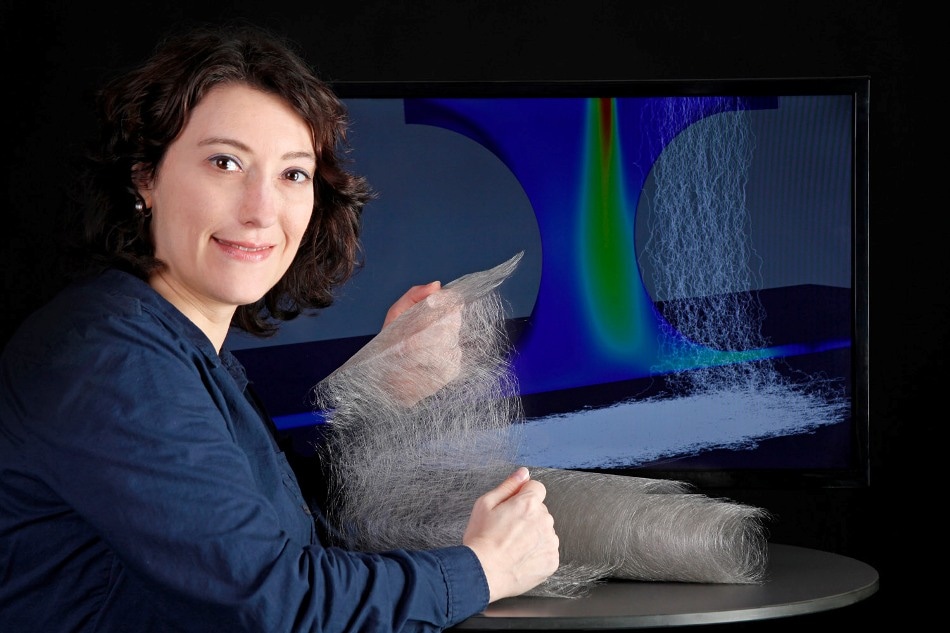Mar 2 2017
 High-tech material non-woven: Project manager Dr. Simone Gramsch has developed the simulation tool FIDYST with her team. The simulation of fiber movements in air flows improves the production of non-woven materials. Copyright Photo Fraunhofer ITWM
High-tech material non-woven: Project manager Dr. Simone Gramsch has developed the simulation tool FIDYST with her team. The simulation of fiber movements in air flows improves the production of non-woven materials. Copyright Photo Fraunhofer ITWM
Non-woven fabrics have become an essential part of people's everyday life. New software developed by a Fraunhofer Institute makes the production of non-woven products more flexible and efficient.
For the first time, it has been possible to simulate the movement of fibers in turbulent air flows with the FIDYST tool. It is a real innovation and the breakthrough in a theory that is more than a hundred years old.
As non-woven materials are usually hidden, they are not visible. However, if anyone is looking for them, they can be found everywhere – as a filter in kitchen exhaust hoods, as insulation in house walls, as a cosmetic pad in bathrooms, as a padding in sofas, as a lining in winter jackets, as a separating layer in electric cables, or as a soundproofing mat in cars.
Highly absorbent non-woven can even be found in the diapers of little children. This non-woven material is a high-performance and very versatile material that has become indispensable to people’s everyday lives. Therefore, mechanical engineers and textile manufacturers are interested in keeping the production of non-woven materials as flexible and efficient as possible.
The special software, known as the FIDYST tool (Fiber Dynamics Simulation Tool), was developed by the Fraunhofer Institute for Industrial Mathematics ITWM in Kaiserslautern. It simulates the movement of fibers in turbulent air currents. During the production of non-woven materials, the threads or fibers are stretched with the help of air and deposited onto a conveyor belt.
Subsequently, a non-woven product with the desired strength, structure, and density can be produced depending on the temperature and speed of the air stream. Random web is a widely used application, where the individual fibers display a different orientation and form a random web which is simultaneously firm and voluminous.
The newly developed simulation software FIDYST determines how precisely the fibers move in the airflow and in which direction they land on the conveyor belt. After simulating the airflow, the user just need to enter the fiber material properties in the software.
Then, the software simulates the dynamic behavior of thousands of fibers. Even fiber mixtures can be simulated using this software. The result can be viewed in a three-dimensional representation.
This data, for example, can help the manufacturer to enhance the air flow in a targeted manner. This can help produce a non-woven fabric with the desired specification while simultaneously reducing the consumption of energy and raw material. The software simulation can determine that by changing the machine’s configuration, fewer fibers are required to produce a non-woven fabric with the desired strength and structure.
The Fraunhofer tool not only helps the textile manufacturers who want to precisely configure their machines for desired non-woven products.
Mechanical engineers can also use it to create machines that are as efficient and flexible as possible.
Dr. Simone Gramsch, FIDYST Project Manager at ITWM
Despite of its complex computing operations, the FIDYST tool does not rely on expensive, high-performance computers or data centers. It is content with traditional PCs of the upper performance class and operates on both Linux and Windows platforms.
Unique feature of Fraunhofer
Once the calculation is performed, the data can be exported in the "EnSight Gold Case" file format and then visualized and analyzed. The file format is standard in applications that manage the visualization and analysis of all kinds of flow dynamics, such as in automotive and aircraft engineering, but also in medicine and sports.
Behind the FIDYST tool is a real world first. It has been possible to precisely simulate and predict the dynamics of fiber in air currents for the first time.
The development is the result of several years of research as well as a few doctoral theses. It has been worth it, though; with FIDYST, we have a unique feature.
Dr. Simone Gramsch, FIDYST Project Manager at ITWM
The ITWM licenses the software to textile manufacturers or mechanical engineers. "If necessary, we also offer FIDYST as a service; then, all the simulations are executed on our computers according to the specifications of the customer," says Gramsch. Therefore, this is useful when it comes to particularly complex and computer-intensive projects.
This topic could be of more interest to mathematics lovers for another reason. Over 100 years ago, French mathematicians Eugène and François Cosserat developed equations to explain the behavior of elastic materials. The Cosserat-Rods theory, named after the brothers, created the basis for the Fraunhofer scientists.
A demo of FIDYST will be presented at the INDEX non-woven trade fair in Geneva (April 4 - 7, 2017) by the Fraunhofer scientists.